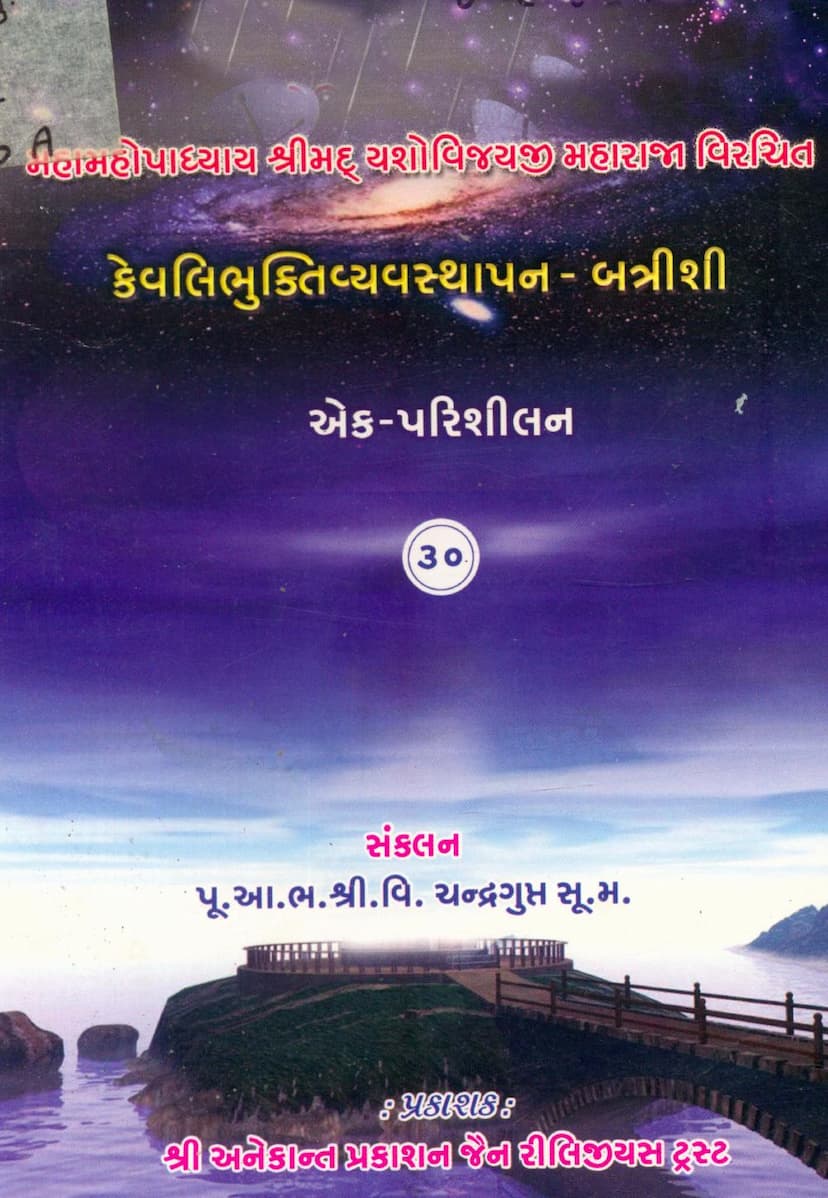Kevalibhuktivyavasthapan Batrishi Ek Parishilan
Added to library: September 2, 2025

Summary
Here's a comprehensive summary in English of the Jain text "Kevalibhukti Vyavasthapan Batrishi Ek Parishilan" by Chandraguptasuri, based on the provided pages:
Book Title: Kevalibhukti Vyavasthapan Batrishi Ek Parishilan (An Examination of the Thirty-two Verses on the Management of the Food of the Omniscient)
Author: Chandraguptasuri
Publisher: Anekant Prakashan Jain Religious Trust
Core Subject: This text is a detailed examination and refutation of the Digambara Jain belief that an omniscient being (Kevali) does not partake in food (Kevali-bhukti or Kavalahara). The author, Chandraguptasuri, aims to clarify the Shvetambara perspective on this matter, which asserts that Kevalis do consume food.
Central Argument and Structure:
The book is structured as a detailed analysis of thirty-two verses (Batrishi) attributed to Mahamahopadhyay Shrimad Yashovijayji Maharaj, which specifically address the Digambara arguments against Kevalis eating food. Chandraguptasuri's work is a commentary and clarification of these verses.
The core of the text involves:
- Presentation of Digambara Arguments: The book begins by outlining the specific reasons provided by the Digambara tradition for their belief that Kevalis do not eat. These arguments are presented in the initial verses (approximately five verses).
- Refutation of Digambara Arguments: The majority of the text is dedicated to systematically dismantling each of the Digambara arguments. Chandraguptasuri, through his commentary on Yashovijayji's verses, meticulously refutes each point raised by the Digambaras.
- Defense of Shvetambara Viewpoint: By refuting the Digambara claims, the author implicitly and explicitly supports the Shvetambara view that Kevalis do consume food. The text highlights the perceived "innocence" and correctness of the Shvetambara position once the Digambara arguments are nullified.
Key Digambara Arguments Addressed and Refuted:
The Digambara arguments, as presented and refuted in the text, revolve around the idea that eating food would contradict the state of perfection and liberation achieved by a Kevali. These include:
- Absence of Defects (Dosh Viraha): Kevalis have overcome all defects. Hunger is considered a defect, so they would not eat.
- Fulfillment of Purpose (Krutakrityata): Kevalis have achieved their ultimate goal, so they no longer need to engage in activities like eating, which are driven by needs.
- Absence of Desire for Food (Aahar Sanjna Viraha): Kevalis are free from any desire or consciousness related to food.
- Attainment of Infinite Bliss (Anant Sukha Sangati): Having infinite bliss, they would not be subject to the discomfort of hunger, which necessitates eating.
- Burnt Cord Analogy (Dagdha Rajju Samatva): The karmic tendency (Vedaniya Karma) that causes hunger is like a burnt cord, no longer capable of binding.
- Indifference to Sensory Pleasure/Pain: Happiness and suffering related to the body are mediated by the senses, which Kevalis are free from.
- Absence of Mohaniya Karma: Due to the absence of Mohaniya Karma, they cannot engage in activities related to external objects, including food.
- Absence of Shata Vedaniya Udheerna: The karmic condition for pleasant sensations (Shata Vedaniya) is not present in a way that would prompt eating.
- Avoidance of Indulgence (Pramada): Discussing food (Aahar Katha) can lead to indulgence (Pramada), and actual eating is a greater cause of indulgence.
- Prevention of Sleep and Waste of Meditation/Tapas: Eating leads to sleep and can disrupt meditation and ascetic practices.
- Body Sustenance Without Food: The Kevali's body (Paramoudarika) is inherently capable of sustained existence without food.
- Avoiding Harm to Altruism (Paropakar Hani): Eating would interrupt their activities of helping others.
- Disgust from Bodily Functions (Purishadi Jugupsa): Eating leads to bodily waste, which is a source of disgust, something a Kevali would avoid.
- Prevention of Illness (Vyadhi Utpatti): Eating can lead to illness, which a Kevali would naturally avoid.
Chandraguptasuri's Refutations:
Chandraguptasuri's commentary systematically addresses each of these points, offering counter-arguments based on Shvetambara philosophy. For example:
- On Defects: Hunger and thirst are seen as consequences of residual aghati (non-destructive) karma, not essential defects that negate omniscience.
- On Fulfillment: Fulfillment (Krutakrityata) is achieved through the destruction of ghati (destructive) karma, not necessarily the complete eradication of all physical needs. Siddhas are truly free from all needs, while Kevalis still possess a subtle body.
- On Sensory Experience: While Kevalis are free from the attachment and aversion associated with sensory experiences, they can still have a refined, non-binding awareness of bodily sensations. The argument that eating implies sensory attachment is countered by the idea that the Paramoudarika body functions differently.
- On Body Sustenance: The text explains that the subtle nature of the Paramoudarika body allows for sustenance without gross food intake, but this does not preclude the possibility of consuming it. The analogy of plants surviving on water is used.
- On Mohaniya Karma: Activities like eating are not solely driven by Mohaniya karma; they can also be influenced by the nature of the body and residual karma.
- On Indulgence: The context and intention behind food consumption are crucial. A Kevali's consumption is not driven by indulgence but by the specific nature of their state and the subtle body.
- On Digambara "Shame" (Lajja): The author provocatively suggests that if Digambaras feel shame about Kevalis eating, they should logically also feel shame about them having a human body and should worship formless deities like Shiva instead. This highlights the perceived inconsistency in the Digambara position.
Concluding Remarks:
The text concludes by emphasizing that the refutation of the Digambara arguments ultimately validates the Shvetambara understanding of Jain doctrine. The author expresses that by understanding these principles, one can truly appreciate the teachings of the Tirthankaras and experience joy in the triumph of the Jain Shasan. The work is presented as a defense of the Shvetambara tradition against what are considered misinterpretations or dogma from the Digambara school.